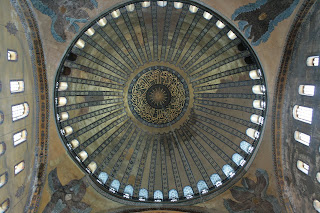 |
| Photo by Tim Kent |
 |
| Photo by Tim Kent |
From the date of its dedication in 360 until 1453, Saint Sophia served as the Greek Patriarchal Cathedral of Constantinople, except between 1204 and 1261, when it was converted to a Roman Catholic cathedral. The building was a mosque from 29 May 1453 until 1931, when it was secularized and opened as a museum in 1935. In Turkish it is known as the Aya Sophia, which is where we get our mispronunciation of Hagia Sophia.
The first room reveals the age and amount of work needed to restore the place. Of course because the museum intends to show both Christian and Islamic cultures present in the building, it can not completely "restore" as that would remove much of that influence.
The court that leads into the main room has the famous Imperial Gate Mosaic (the first picture) through which only the Sultan and family could enter. The rest of the room is decorated by some amazing pink marble that was sliced on site and placed next to itself to create beautiful symmetry. The marble is astounding and worth enjoying for its own abstract expressionism.
 |
| Photo by Tim Kent |
 |
| Photo by Tim Kent |
 |
| Photo by Tim Kent |
 |
| Photo by Tim Kent |
The bells, altar, iconostasis, and sacrificial vessels were removed and many of the imagery was plastered because Islam bans representational imagery. The archangels above were hidden and are slowly being revealed through the restoration work that my guide informed me is largely done by graduate students. The mihrab (what appears as the gold altar below), minbar (the gold stairs on the right of the mihrab), and four minarets were added in 1453 when Sultan Mehmed II conquered the city.
The last picture is taken from the second story which one gets to by walking up a ramp, the same ramp used by the donkeys to carry the marble to decorate and build that height.
 |
| Photo by Tim Kent |







No comments:
Post a Comment